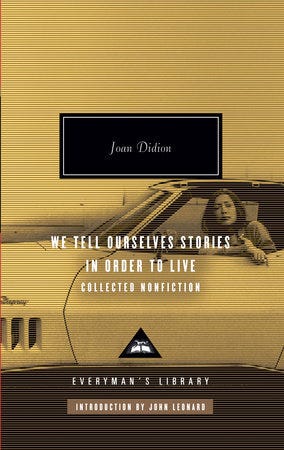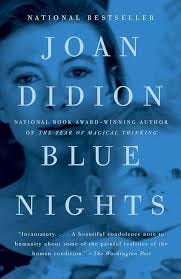Joan Didion and the Dissolution of Patterns
Some thoughts after reading excellent essays about Didion's "Blue Nights"
I have a beautiful Everyman’s Library edition of Joan Didion’s nonfiction that I’ve been reading my way through over the past few years, mostly without a plan. The title of this particular collection is the famous line from the title essay in The White Album: “We tell ourselves stories in order to live.” Yes, we live by stories and we die by them, I think when the elegance of that line provokes me to think through it yet again.
We use the same words to tell the truth as we do to lie. And we sometimes comfort ourselves (I know I do) with a belief that lies eventually sink under their own weight, that the fraudulent stories, the delusions, don’t hold up to scrutiny. But Didion knows that the desire for story is stronger than the feeble desire for truth.
The longevity and persuasiveness of a story are not rewards for veracity or honesty. (Verisimilitude will often suffice.) The stories that are not true play different roles.; deceit is only one of many. “Repression,” that monster pried from under our imaginary beds by psychoanalytic critics and those who want to believe themselves unrepressed and shadowless, often holds the unnameable together and at bay, making other stories possible.
We can pick our story apart safely only under certain conditions.
We can only write in order to find out what it is that we think — as Didion says in the essay “Why I Write” — if the narrative we will take apart can no longer be lived in. Otherwise, we’d be buried under its rubble. (I imagine that some stories we tell ourselves are like houses.)
This is how Didion describes the life-giving, if potentially self-deceitful, art of story-making in that paragraph of The White Album’s title essay which begins with “We tell ourselves stories in order to live”:
We interpret what we see, select the most workable of multiple choices. We live entirely, especially if we are writers, by the imposition of a narrative line upon disparate images, by the ‘ideas’ with which we have learned to freeze the shifting phantasmagoria which is our actual experience.
Here is the imperfect but life-giving force of story-making. Stories that sew experience together, patch holes in the maps of lives. (Here I imagine that stories are not so much houses as garments and realize that I’m stuck with the two ill-matched metaphors and can’t write my way out.)
By contrast, in The Year of Magical Thinking and Blue Nights, Didion seems to me to have managed to do the opposite: to write as if with scissors, to undo the story in the act of telling. This accomplishment of her writing brings to my mind these Buddhist verses:
O housebuilder, now you are seen! You will not build the house again:
all your rafters have been broken, and the ridgepole has been destroyed,
my mind has reached the unconditioned, and craving’s end has been achieved.1
Is it possible to no longer need to find one’s home in a story, to no longer thread the threads together?
In Blue Nights, this passage stopped me in my tracks:
"What we need here is a montage, music over. How she: talked to her father and xxxx and xxxxx-
"xx," he said.
"xxx," she said.
"How she:
"How she did this and why she did that and what the music was when they did x and x and xxx-
"How he, and also she-"The above are notes I made in 1995 for a novel I published in 1996, The Last Thing He Wanted. I offer them as a representation of how comfortable I used to be when I wrote, how easily I did it, how little thought I gave to what I was saying until I had already said it. In fact, in any real sense, what I was doing then was never writing at all: I was doing no more than sketching in a rhythm and letting that rhythm tell me what it was I was saying.
[...]
I supposed this process to be like writing music.
I have no idea whether or not this was an accurate assessment, since I neither wrote nor read music. All I know now is that I no longer write this way. All I know now is that writing, or whatever it was I was doing when I could proceed on no more than "xxx" and "xxxx," whatever it was I was doing when I imagined myself hearing the music, no longer comes easily to me. For a while I laid this to a certain weariness with my own style, an impatience, a wish to be more direct. I encouraged the very difficulty I was having laying words on the page. I saw it as evidence of a new directness. I see it differently now. I see it now as frailty.
Both The Year of Magical Thinking (which, unfortunately, I remember less precisely than I wish and would need to reread) and Blue Nights (which I only just read this year) brought me up close with an awareness — half-uncomfortable, half-sublime — that writing can also undo threads of narrative, unknot meanings that might have seemed so well done as to appear inevitable, and uncreate a story that was there or should have been there based on sensible expectations.2 That long passage I just quoted above and feel unequipped to comment on, illustrates to me this act of undoing.
Everything that I’m writing here coms from not so much to my own recent reading of Blue Nights, which left me pretty tongue-tied, but thanks to two essays that talk about two significant narrative threads that the book unknots.
The first of the two, Brad Skow’s “Social Experiments, with Joan Didion,” led me to think about the way Didion’s interrogation of her memories points to the ways in which adoption comes with ill-fitting narratives. It is framed as a solution (not that it does not offer a solution, but it is never exclusively just that); it used to come with the possibility of concealment (and the pain of a dramatic reveal); it can be framed as substitution of one family with another, or of loss with gain. None of these are satisfying narratives, however, for the adopted child.3 The truth, as Didion shares with the readers, is also not a matter of satisfaction. The story of her adoption becomes for Didion’s daughter a point of origin for her unlived lives, a point at which the potential loss of her adoptive family might have taken place due to a similar accident of chance that gave her that family. What if no one picked up the ringing telephone? What if a different decision had been made? (What if? what if? what if?…)
Kate Jones’s essay, “Joan Didion’s Blue Nights” on the other hand, made me think of the ways in which motherhood collides with stories about it. As Kate Jones points out, Didion’s candor about feeling unprepared for motherhood and about the details of the family life created by two incredibly successful writers makes her an easy target for those critics who are on the lookout for opportunities to point out and condemn signs of “a life of privilege.” She also astutely points out that those same critics would likely prefer to ignore the fact that Didion already supplied their ammunition because her self-examination outran their accusations.4 In fact, Didion dives back into her memories with questions that at times feel like self-flagellation. Having abandoned the writing strategies she relied on earlier, Didion strips her prose so bare in Blue Nights, her self-questioning is painful to witness — she leaves the reader no allusion, no reference, no metaphor to hide in. There are places in the narrative where the accumulation of question marks is like a barrage. If Quintana fell into rumination about her own unlived alternative lives, her mother uses questions about paths not taken to consider her own responsibility for what might have been but wasn’t, to chase her past self through junctures in the past that may not have even been apparent as junctures. To put it plainly, there are moments where the Joan Didion who is writing is cruel toward the Joan Didion who lived in those moments, and the reader is stranded between the two Joan Didions, unable to offer consolation.
And here I run out of things to say apart from looking for comfort in literary parallels. I catch myself thinking about Didion’s writing and Penelope undoing the funeral shroud in The Odyssey. But Didion’s narrative undoing does not lead to a turning point — her daughter cannot be brought back. I catch myself thinking about Didion and Orpheus trying to save Eurydice. But Quintana in Didion’s retelling of moments from their life has her head turned away toward the past, there is no way out, and Didion is not imagining herself as Orpheus, it’s all me. I’m the unconsoled reader.
Thanks to Kate Jones and her essay about Blue Nights, I learned about Petya Grady’s Joan Didion Project. I’m not a paid subscriber currently (yet?) but want to recommend the newsletter. I loved this post from the project — I think of it as a readerly mise-en-place.
Such as our familiarity with certain narrative forms, our knowledge of life, and our basic hunger for stories.
Here I feel I need to link to Meghan Daum’s essay “Difference Maker,” which considers adoption and foster care from a largely unexplored angle that shows more dimensions of the system in which adoptions happen, and the lives children live as they wait for adults to make decisions.
Here an essay by Myriam Gurba comes to my mind. It is well written — Gurba’s language is cutting and the essay has an engaging tempo, a gallop of accusations — but by accumulating expressions of disdain for Didion’s privilege, it turns Didion merely into a convenient scapegoat for larger issues of inequality, poverty, scarcity of opportunities. The deeper I read into it, the more it seemed to me that Gurba was putting Didion on trial pointlessly, demanding things that a single person could not possibly deliver, did not owe others, and was not really responsible for in any tangible way.




I really like both the house and garment metaphors for story. I need to think more on those. Also, I've been meaning to read Joan Didion for so long. Thank you for bringing her back up to my attention!